#wowieweirdwarlock
Explore tagged Tumblr posts
Note
Hello!! I love your blog!! It’s a major inspiration for my own !!
I was wondering what your thoughts are on the demon lord Mestama— she’s my favorite!
I love hags of any variety, especially the Mother of Witches herself.
I think it's funny that one of her Boons lets you slap someone so hard they just can't have kids anymore. And the one before that transes your gender if you weren't already a woman.
As for her personally, I like her! She completes the trifecta of Hag Goddesses but, ironically, works against the other two jealously because she wants to be the only one around. Among the Hag Goddesses, though, she's the most hag-like; the most haggish, if you will. Her servants make excellent villains when a wicked witch-type character is needed, as followers of Mestama need little reason to commit their terrible deeds.
In fact, there's a built-in plot hook in her lore: Mestama hates both Gyronna and the Queens of the Night to the point that cultists devoted to any of them act as a sort of protection against cultists of Mestama, as their efforts are directed at the rival cults instead. A servant of Mestama may hire the adventuring party to be rid of an evil cult of a diabolic queen or the Angry Hag, only to eventually reveal themselves as an even worse and more overtly hostile threat!
12 notes
·
View notes
Text
Best Bosses: The Mistress of Midnight Teeth.
Source: Tome of Beasts 2
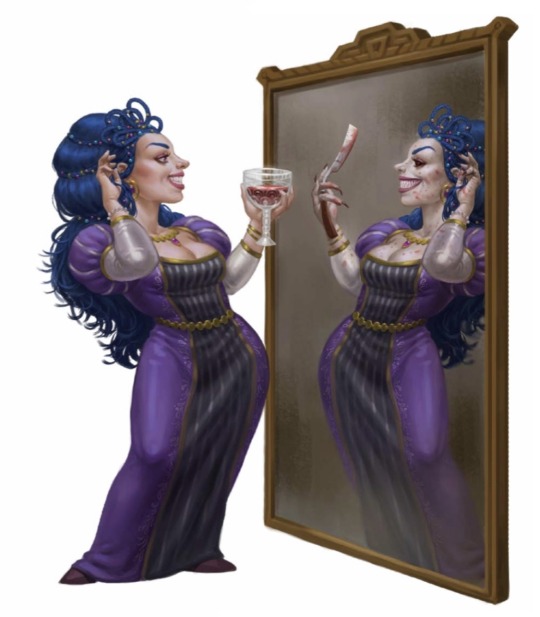
Image Source: Tome of Beasts 2, pg. 147.
“The elegant gnomish noblewoman smiles, flashing dazzling white teeth in contrast to her rich blue hair, and moves with fluid grace past a mirror. As she passes the mirror, her reflection briefly shows old blood caked on her face.”
Phylomara Gladrienne, mistress of the Court of Midnight Teeth, is one of the most influential of the shadow archfey. She appears as a refined gnome, bedecked in fashions such as fine silk and jewels that always compliment her inky blue hair. She loves styling her hair very elaborately, and insists on never appearing with the same style twice.
Mistress of The Blue Barbers. The Mistress’ gnome courtiers in her home also serve her as agents abroad. Known as the Blue Barbers, they are defined by their blue hair and desire to bring style into the lives of all they meet. They are polite and social, offering services as decorators, artists, information brokers, and stylists of all varieties.
Hungry for secrets. The main reason Blue Barbers are so gregarious is due to their Mistress’ endless hunger for secrets. She is desperate for gossip and interesting facts, and ever-eager to learn information regarding unique and interesting individuals. She is particularly stealthy, using her knowledge of darkness and manipulation of shadows to manipulate people from behind the scenes of her decadent parties.
Ravenous for Flesh. Beneath the Mistress’ facade of style and politeness, her darker side reveals itself in too-sharp teeth and strange reflection. She is always hungry, and her court constantly works to bring her fresh meat to devour. Any and all who cross the Mistress of Midnight Teeth discover that her hunger is something formidable, endless, and evil.
Knowledgeable Hostess. The parties and banquets the Mistress throws are well-renowned for their decadence, with Fey and other beings flocking to her dappled gardens to partake in strange games of intrigue and gossip. Those looking to earn the Mistress’ favour would do well to attend such a party and engage with her court, for she is very knowledgeable about a wide variety of topics. Those seeking her wisdom must be prepared to trade their own secrets in return, or at least a bit of flesh.
The Mistress’s Lair:
The Mistress makes her home in the Court of Midnight Teeth, a massive marble and silver mansion in the Plane of Shadow. Gilded mirrors hang on every wall to reflect the stylish Blue Barbers wandering about, each attended to by hosts of goblin house servants.
Within her home, the Mistress is all but immune to damage, as she can shunt injuries off to her reflections in the surrounding mirrors. As she stalks her halls, she often stops to consult her imperfect replicas in every mirror— her reflections are monstrous and often covered in bruises or cuts, revealing the Mistress’ darker personality within.
In addition to using her reflections defensively, the Mistress has other uses for her glittering copies. Her Reflections appear in every reflective surface near her, including puddles or metal, which she can cause to reach out to attack nearby creatures. She can also step into any reflective surface, walking through them similarly to portals to appear somewhere else.
Along with manipulating her reflections, the Mistress also has control over the darkness in her realm, and is capable of casting the area into a sphere of gloom in order to make it more difficult to navigate her halls.
While within her home, beings experience strange effects. Humanoids wake up every day intensely hungry, experiencing unknown cravings that cannot be satiated unless at the Mistress’ dining table. Reflections within three miles of Her lair move of their own accord when unobserved.
The Mistress may scry the location of any being in her home by casting her sight through a mirror, and can extend this ability to any mirror near one of her Blue Barber servants, quite literally giving her eyes and ears across the multiverse.
Ideas for using the Mistress of Midnight Teeth in your campaign:
A charismatic, blue-haired gnome appears to the party, offering them an invitation to one of their Mistress’ exquisite banquets. After they arrive and enjoy Her hospitality, the Mistress informs them they may not leave until sharing a few secrets with her. If they don’t, she is perfectly happy bringing them to her next party… as the main course!
The party needs information, be it a secret regarding an enemy or the location of an ancient treasure. They must meet with the Mistress of Midnight Teeth in order to get the information out of her, and must sneak past her small army of Blue Butlers who are constantly on the lookout for those without an invitation.
Another Archfey is looking to get back at the Mistress for exposing one of their secrets, and has enlisted the party to aid them. They must go to her annual birthday banquet and steal the main course, replacing it with something vile covered by an illusion. When the party gets there, they discover the main course isn’t what they expected— it is a group of humans, who they now are responsible for getting out safely.
I believe the Mistress and I, were it not for her garish appetites, would get along swimmingly. We both have quite the desire for knowledge, and I’d love to wrack her brain for secrets regarding some hard-to-reach lore.
Of course, I don’t believe the price I’d have to pay to access that knowledge would be quite worth it.
As fun as her events are, and as useful as she is, the Mistress only ever looks out for her own needs, and only ever wants two things: Fresh gossip and fresh meat.
- A Weird Warlock.
#wowieweirdwarlock#pathfinder#ttrpg#d&d#dnd#d&d monster#pathfinder lore#www: best bosses#Mistress of Midnight Teeth#Archfey#Fey#Lore#worldbuilding
13 notes
·
View notes
Text
Sorry, not sorry, if you've been pinged before
@themostscrumpdiddlyumtious @irlactualwizard @forgettable-dumbass @number-1-haxorus-fan @carnivalwizard @a-mushroom-wizard @opalescent-apples @pixelmade42 @fallow-grove @anti-wizard-council @toastedpoptartsarelife @robocultist @lukadjo @luxionoteb00k @kronyxthewizard @bil-daddy @insomber1 @terrencetheshark14 @braed331 @aroace-wizard @lixorloveslicorice @slymewizard @the-wizard-of-revolution @your-third-cat @shittest-wizard-ever @lovedtogekiss @opalescent-apples @mayhem-moth @f-aha-efolk @workslikeclockworks @gengarkisser @sidewalktechnician @fexarii @phlo0p @nyargwet-thwacher @eldritchcatpossumamalgam @alchemycentral @frungle-bobungle @jhomikle @wizard-wylin-wylerian @wowieweirdwarlock
k i'll hop on the bandwagon
800 notes and i'll read homestuck
868 notes
·
View notes
Text
Encounters & Extras: 15 ways to use Mimics!
A mimic disguised as a potion of health, or regeneration. The party receives it in a dungeon or at a shop, and could ambush them when they’re already low on health. Good for incapacitating a party member.
A Mimic disguised as a common tool, such as an artisan’s tools or lockpicking kit. It could sneak into a character’s pack, or be looted from an enemy.
A Mimic disguised as a spellbook. A highly intelligent Mimic, capable of casting a few cantrips due to the spells contained within it.
A Mimic disguised as a topiary. Could be hidden within a garden or castle. Unbeknownst to its caretakers, every time is it trimmed, it simply sprouts smaller mimics that take root in the garden. Soon it will grow into a whole colony.
A Mimic disguised as a plate of food. Imagine the kind of face-hugger shenanigans that would ensue.
A mimic disguised as a lantern or torch, which plunges the party into darkness at a crucial moment.
A mimic disguised as a suit of armor. Could actually make a very nice and useful pet, if regularly fed so it’s not tempted to just consume whoever gets in it,
A mimic disguised as a small hand puppet. Anyone who thinks to use the small toy finds their hand bitten off, and a small mimic quickly spreading up their arm.
A mimic disguised as a deck of cards. Could be suited for casinos or taverns, taking advantage of gamblers’ distraction.
A mimic disguised as a blanket or bedsheet. The next tavern room the party chooses to relax in could be turned into a very surprising encounter.
A baby mimic disguised a map. The only course it knows how to make appear is a direct path back to the colony it spawned from, leading any would-be treasure hunters directly onto a trap.
A very large mimic disguised as a stable. It is no longer satisfied with smaller prey, and aims for the horses that get boarded up within it.
A mimic disguised as a Jewelry box. It is employed by a merchant or noble for protection from assassins.
A mimic disguised as a bow. When someone attempts to use it, it loses shape and wraps tightly around their arm.
A mimic disguised as a mirror. It changes the reflective surface with simple shapes and colors to confuse those looking within, beckoning them closer.
8 notes
·
View notes
Text
Tips & Tactics: Wizard’s spellbooks.
Not every wizard has to have a large, expensive tome to record spells in.
What if, since there is such a wide array of different wizards in the multiverse, we got to see an equally diverse range of ways to record spells?
Here are a few ideas:
Tattoos. A wizard could ink their spells known directly into their skin, making them very convenient to keep with them. This could have drawbacks, as a wizard may need to magically remove unused spells in order to provide room for newer ones.
Memorization. The wizard records spells using a complex mnemonic device. They prepare their spells each day by reciting the device pertaining to the spells they want for that day.
Cookbook. For the culinary-inclined Wizard, why not include your favorite recipes and spells in the same place? If you think about it, you can format spells almost exactly in the same way as recipes.
Ring. A simple ring, with illusory magical script floating around the band. The wizard can focus on a particular spell to summon it forth on the ring’s surface.
Scarf. An insanely long knit scarf, which the wizard spends a little time knitting each time they learn a new spell. With specially coded stitches and loops, the wizard can store their spells within the scarf.
Mirror or Spyglass. Instead of a spellbook, this wizard can use a mirror with different slots for special panes of glass. Each pane is watched with different magical knowledge, allowing the wizard to swap out and bring to the front the most relevant spells.
Undead vermin. Perfect for the Necromancer on the go, this spellbook consists of a small being preserved with magic, which recites spells whispered to it. Can take the form of a rat carried by the tail, a snake coiled around the arm, or even a goblin’s head on a chain.
Dragon’s Eye. Literally, a dragon’s eye gouged out and used to replace one of the Wizard’s eyes. Enchanted so the wizard can see an illusory display of their spells known.
Aberrant Visitor. The wizard has a strange symbiote from behind reality living in their body, which whispers arcane knowledge to them.
Origami. A delicate piece of paper that is very carefully folded. Can be unfolded into a large amount of variations, with spells written on each one.
#wowieweirdwarlock#d&d#d&d homebrew#pathfinder#dnd#d&d wizard#wizard#pathfinder wizard#WWW: Tips & Tactics#ttrpg
12 notes
·
View notes
Text
Major Monsters: Pact Lich
Source: Creature Codex

Image source: Creature Codex, pg. 253
“Despite its frail appearance, this rotting, fiendish creature commands considerable arcane power.”
The Original. The first pact Lich was a powerful warlock whose patron was a being of undeath and magic. In a dire moment, the Patron decided to bring back it’s fallen servant as a being of dark intelligence with a hunger for souls.
Soul Devourers. Pact Liches must bring souls to their patron, for fear of their continued existence being snuffed out. Most Pact Liches possess a special item, such as a large diamond or magical focus, known as a phylactery, that they drain souls into to supplicate their patron.
Magical Rebirth. When a Pact Lich’s body is destroyed, their essence and consciousness is sent back to their patron, whom the Lich must face for their failure. If it’s patron is feeling particularly merciful, the Lich will be returned to the Material Plane near the object that serves as its phylactery.
Unique undeath. While all Liches require life force and magic to keep themselves existing beyond death, Pact Liches are the only ones that rely on the will of another being. As such, Pact Liches are unendingly loyal to their patron, as their entire soul and consciousness could be snatched from their body on a whim.
Ideas for using Pact Liches in a campaign:
A worshipper of a powerful arch fiend has been brought back after being slain by the party, and is amassing a cult around themself. They intend to hunt down the party and sacrifice them to their patron.
A member of the party’s soul has been trapped in a Pact Lich’s phylactery, and the party must kill the lich, and then destroy the phylactery before the soul js absorbed by the patron. While trapped in the phylactery, the Patron may offer a pact to the Player’s soul in exchange for freedom, as the Pact Lich has been disappointing the patron.
A warlock ally of the party has been slain, but suddenly came back. Despite this seeming miracle, they are acting strangely and are more dedicated to their patron than ever. Unbeknownst to the players, the ally has become a pact lich, and intends to sacrifice one of the players’ souls in order to cement their undeath.
There are many ways to achieve lichdom. In my personal opinion, Pact Liches are the most unique of all of them.
Most pact Liches serve their patrons unerringly, as most Patrons that grant this boon tend to be beings of Undeath or Darkness that do not suffer disobedience. Some patrons, such as Archfey or Fiends, also see the value in keeping particularly beautiful or loyal warlocks alive beyond death.
Many pact Liches are quite sad beings, as their whole existence hinges on the decisions and satisfaction of another. At least in life, some warlocks get a little bit of independence beyond their patron.
Pact Liches, however, are emptied of life force and ambition by their patron, and many are molded to suit their patron’s desires.
Luckily, I was spared that fate. My patron keeps me around as long as I make myself useful, sure, but at least I have a decent bit of latitude in my decision-making.
- A weird warlock.
8 notes
·
View notes
Text
Radical Races: Dhampirs.
Source: Advanced Race Guide & Blood of the Night.
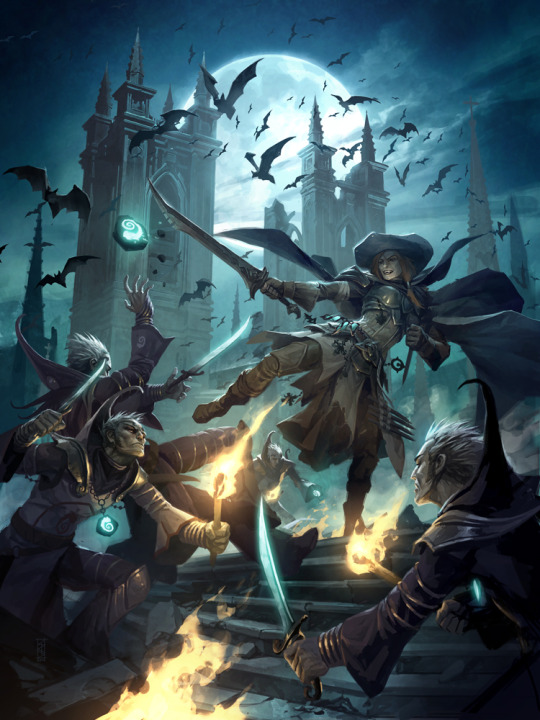
Image source
“The half-living children of vampires birthed by human females, dhampirs are progenies of both horror and tragedy. The circumstances of a dhampir’s conception are often called into question but scarcely understood, as few mortal mothers survive the childbirth.”
Many different schools of thought argue on the origin of Dhampirs, but all agree they are born of suffering. One possibility is that they are the natural spawn of vampires coupling with humans, and another is that they form when a pregnant mortal is bitten by a vampire. Some zealous scholars even claim that they aren’t their own race at all, merely mortals suffering under a vampiric curse.
Dark Children. Dhampirs enter the world embraced by pain and rejection. Despite their natural vampiric charm, many of them face prejudice and mistrust due to their heritage. Humans who witness a Dhampir child’s supernatural abilities or strange cravings could have an array of negative reactions, further cementing the stereotypes regarding Dhampirs. Because of this, Dhampirs keep few companions, and even with the few they choose to be close to they can be sullen and dark; They fear that their dark natures willl push their companions away, or that their bloodlust will eventually consume them.
Human Passing. Dhampirs tend to take after their mortal parent in terms of appearance. They are often slender, muscular, and statuesque, with unearthly beauty. Their eye, hair, and skin colors appear as unnerving versions of the human parent’s, with many having sallow skin and sunken-in features. Many Dhampirs can pass as human at first glance, but any further attention reveals their strange appearances and fluid grace. Their canines tend to be exaggerated, reflecting their urges to consume blood, despite the substance providing no physical value.
Evil in The Blood. Most Dhampirs have no true culture to call their own, with very few coming together and forming cabals to watch out for eachother. They usually consist of outcasts and exiles, gathering the philosophies and beliefs of societies that reject them. Most Dhampirs tend towards evil, listening to the corruptive power in their blood. They are unnatural beings, and most races view them as scions of evil. A very rare minority of Dhampirs turn against their dark heritage, and turn to lives as vampire hunters. Some do this to track down their vampiric parent, or to simply purge the evil of vampirism from both themselves and the world.
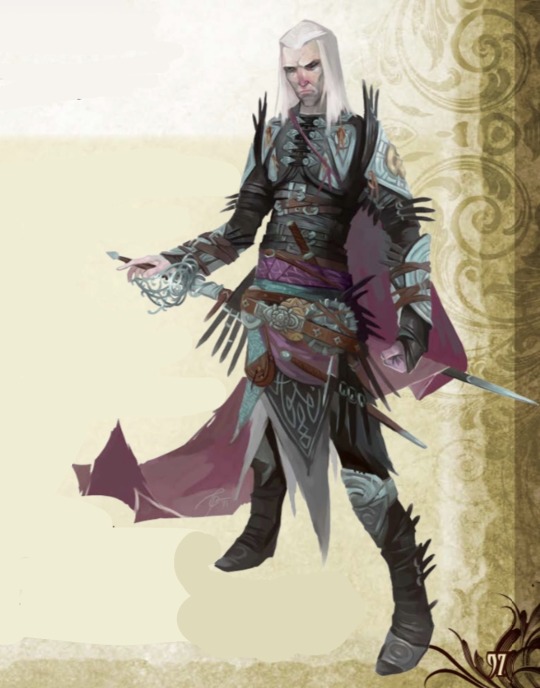
Image Source: Advanced Race Guide, pg. 97.
Vampiric Traits. Dhampirs inherit some, but not all, of their parent’s vampiric gifts. Some traits are common among the Dhampir race, such as light sensitivity, spell-like abilities, and an affinity for negative energy. Occasionally, a unique Dhampir is born with an unusual vampiric trait, such as being able to walk during the day or communicating with beasts of the night. These unique traits often correlate to the conditions of the Dhampir’s birth, as the state of the mortal parent during conception can change the nature of the Dhampir child.
Breeds of Dhampir:
Just as there are multiple clans and bloodlines of vampires, there are different breeds of Dhampir. Each Dhampir inherits some of their vampire parent’s dark legacy, with different vampires spawning different kinds of Dhampir. The four most common Dhampir are:
Svetocher are the spawn of the elegant Moroi, the most common breed of vampires, who value charm and seduction in their hunting. Svetochers tend to have an easier time interacting with mortals than other Dhampirs, due to their unnatural charm and beauty. Since Moroi often choose to interact with royalty, most Svetochers are born into nobility, raised in the shadows of high society. This equips them with the skills necesary to avoid discovery, as many Svetochers excel in deception and intrigue.

Ru-Shi are born from Jiang-Shi, incredibly old vampires bound up in traditions and superstition. They are usually the result of a ritual or magical affect, as few beings would couple with the corpselike Jiang-Shi. They are born with a wasting curse that putrefies them from within, making them graceless and unsettling, with gray skin and unnaturally light eyes. They are often scientifically or linguistically gifted, and prone to strange obsessions and interests.

Ancient-Born are Dhampirs hailing from the Nosferatu, by far the oldest among vampirekind. From birth they are misshapen, with sallow, and tend to hate humanity for the rejection they inevitably face. They often possess their forebear’s eerie powers or arcane gifts, but they lack the immortality that offsets the Nosferatu’s horrific appearance. Due to this, age wears terribly on the appearance of an Ancient-Born.
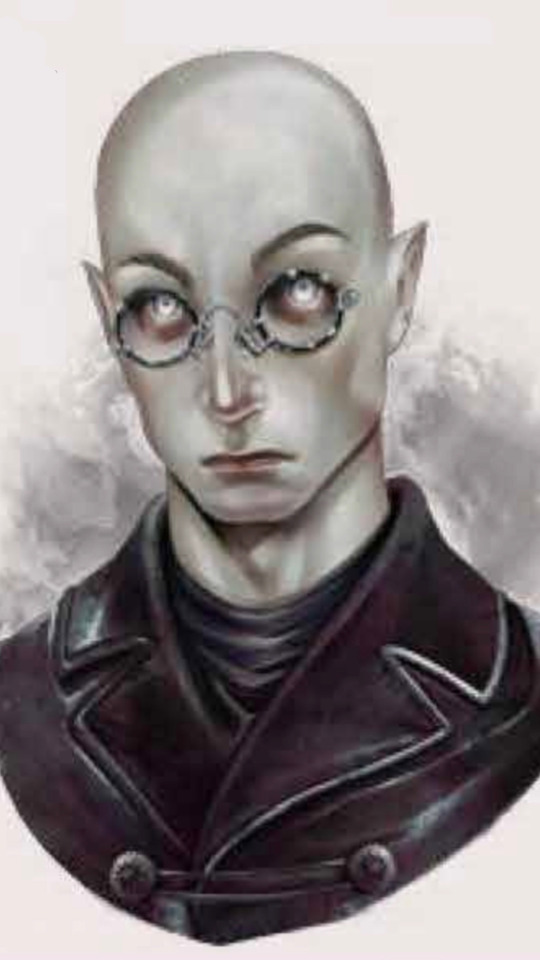
The unique Vetala vampires, with their childlike demeanors and ability to claim the minds of mortals, spawn the strange Dhampirs known as Ahibachana. These Dhampirs are often the result of curiosity or experimentation rather than genuine romance, and are possessed of sharp minds. Just like their progenitors, they possess a thirst for knowledge that pushes them to succeed at everything they attempt. Ahibachana tend to master skills very quickly, and often develop Vetala-like psychic abilities.
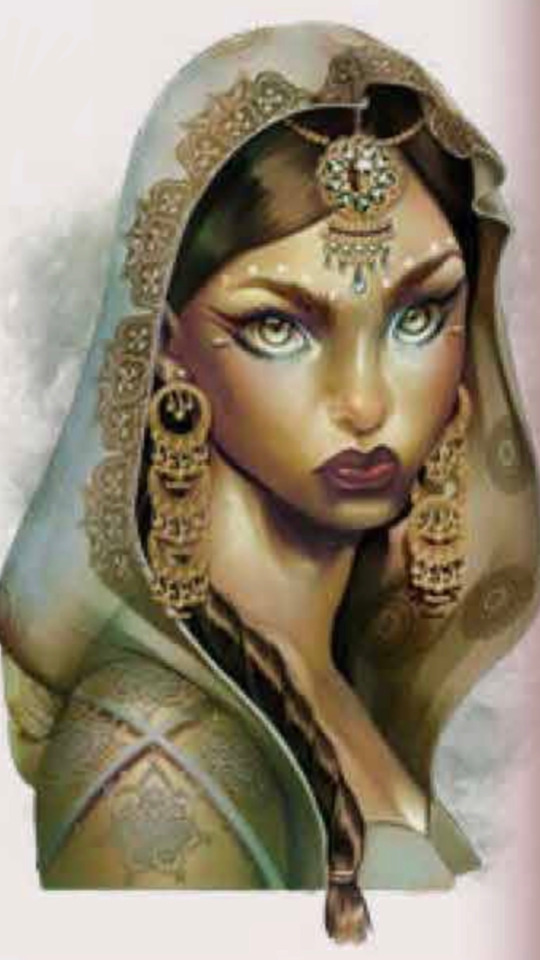
Ideas for using Dhampirs in your campaign:
An insane vampire has been going across the area, targeting pregnant women to feed off of. He is aiming to create a brood of Dhampirs to serve him, so as to have thralls that can survive in sunlight and will inherit some of his vampiric power.
A Svetocher has been manipulating a noble court, paving the way for her Moroi father to come in and take power. The party is hired by a Lord of the court to investigate her and expose the coup.
A Ru-Shi has developed an obsession with a member of the party, and is constantly seeking to hunt them down and taste their blood.
Dhampirs are a unique race, having been born from two worlds but being completely unable to thrive perfectly in either.
Other “bastard” races, such as half-elves or half-orcs, can navigate in the worlds of their parents with a little bit of effort, but Dhampirs are unequipped to choose one over the other.
Their sensitivities and strange cravings make them nocturnal predators among mortals, yet their mortality and empathy marks them as lesser than their vampiric creators.
Some Dhampir philosophers claim that this means they are meant for something different from either parent. These strange scholars speak of a possible society of Dhampirs, where they aren’t viewed as half-breeds or bastards but a powerful and unique race.
Until this vision is realized, most Dhampirs will simply be seen as cursed by mortals and mistakes by vampires.
- A Weird Warlock.
5 notes
·
View notes
Text
Mighty Monsters: Chamrosh
Source: Tome of Beasts 2

Image source: Tome of beasts 2, pg. 59.
“This large sheepdog has luxuriant white-gold fur. A pair of broad wings stretches out from the creature’s back, and it’s eyes are filled with an intelligent, eerie gleam.”
Chamrosh are formed from the souls of the particularly faithful, either attentive guards or those who sacrificed themselves for another. After their death, they are given a new purpose: To defend all that is good and innocent, at any cost.
Celestial Guards. Taking the forms of noble sheepdogs with massive wings, Chamrosh act as guardians of good. They have keen senses, and are able to sniff out even the most deceptive evils. They are steadfast protectors, and will not back down even against the most oppressive foes. Due to this, Chamrosh are often used as guardian beasts by more powerful Celestials, where they will defend a location or individual with their lives.
Defensive Packs. When not attending to their duties, Chamrosh will form packs dedicated to the destruction of evil. They traverse the planes, hunting down fiends and monstrosities while defending innocents. They will often go on missions to rescue those held by evil creatures, raiding fortresses and hostile realms. Despite their bestial forms, Chamrosh are capable of speech and communicate in order to aid their allies.
Roaming Allies. Chamrosh very rarely enter the material plane, and only ever to defend something of importance or to help a divine hero on some quest. They are incapable of changing form, so their missions rarely rely on subtlety. Once they achieve what they set out to do, they are eager to return to their regular duties.
Talk about a good boy!
These winged hounds serve particularly good beings in the multiverse, acting as powerful guard dogs of divine locations and heroes.
I tried to befriend a Chamrosh with a tender cutlet once, but it seems their similarity to dogs is only physical. I still have the scar.
- A Weird Warlock.
#wowieweirdwarlock#pathfinder#ttrpg#d&d#dnd#d&d monster#pathfinder lore#www: mighty monsters#chamrosh#good boy#dog#doggy
2 notes
·
View notes
Text
Mighty Monsters: Psychopomp, Catrina
Source: Bestiary 4

Image source: Bestiary 4, pg. 218.
“With lengthy curling hair, a dancer’s dress, and a bouquet of flowers, this woman remains beautiful, despite having no flesh.”
Catrinas welcome souls into the afterlife, working to soothe the fear and anger of mortals who haven’t accepted their own death. They eschew the funereal clothing and grave appearances of other Psychopomps, opting instead to decorate themselves in festive shades and bright lights to fight off the gloom of death.
Kind, Not Compassionate. Catrinas, despite all their glamor, will never disguise their skeletal forms. For while they seek to aid the transition of troubled souls, they will never deny the finality of death. Catrinas rarely visit the material plane, usually at the command of a more powerful Psychopomp or deity, to aid the transition of an important soul. While they work to ease the feelings of certain souls, they do not care much for their charges, and only do what they do because howling and wailing disrupts the procession of the dead.
Companions, Ushers, and Executioners. In most cases, Catrinas simply accompany souls into the afterlife, or groups of them host receptions for the newly dead. Their magical auras calm negative emotions, allowing souls some lucidity while they face their own mortality. Once a soul is ready, the Catrina guides them to their proper destination in Purgatory, before leaving them to go aid another. If a soul proves difficult, or a living mortal refuses to die, Catrinas are more than capable of taking them by force with their life-ending kiss.
Kiss of Death. Despite their skeletal forms, Catrinas can be considered rather attractive. They are genderless, but some may choose to be more feminine or masculine depending on the role they’re playing at the time. Using their unearthly charm, Catrinas are capable of compelling the restless dead. Usually, this compulsion is very simple: the Catrina demands the soul to kiss it. The passionate kiss of a Catrina will kill a mortal quickly, making it easier to hasten their journey to the afterlife.
Ideas for using Catrinas in your campaign:
A party member died and was resurrected, yet they have no memory of their time in the afterlife, and all seems to go on as normal. Strangely, a mysterious woman shadows the party wherever they go, focused on the previously-deceased party member. If the party investigates, they discover she is a Catrina that was tasked to the party member, who wasn’t expecting them to come back, and is torn between leaving them be or killing them to bring them back to purgatory.
After a total party kill, the Party awakens in the afterlife, surrounded by a reception of Catrinas, who have organized a large party to celebrate the Party’s adventures in life. The party must navigate their way through the party if they have any hope of escaping back to life under the watchful eyes of the jovial psychopomps.
Catrinas, like all Psychopomps, care for the procession of souls to the afterlife first and foremost.
They can dress in bright colors, decorate their realms with pleasant things and light, but they are, above all, agents of death.
They may act graceful and good, but they are just as dangerous as any outsider, and they value your death far more than your life.
- A Weird Warlock.
3 notes
·
View notes
Text
Radical Races: Irii
Source: Planar Adventures

Image source: Planar Adventures, pg. 239.
“This strangely unnerving entity looks like a thin, graceful human, save for its insectile features and shimmering gossamer wings.”
Irii are native to the Dimension of Time, an inscrutable and mysterious demiplane that is all but impossible to explore, even with the most potent planar magic. Many Irii are mistaken for celestials or fey due to their appearances, and their strange behavior does little to enlighten scholars.
Natural Dichotomy. Irii are split cleanly based on their philosophy regarding time, and are in a constant civil war regarding these philosophies. Irii that regard time as unchanging and straightforward are known as Fates; They tend to appear with animal heads, wings made of gold and glass, and unblinking eyes circling their necks. Fortunes are Iriis who view time as elastic and mutable, with humanoid faces, golden horns, and more insectile wings.
Alien Mindsets. It was long believed that an Irii’s outlook was predetermined due to their constant struggles over ethical views. Fates and Fortunes have vastly different ideologies regarding free will, divination, and the cosmic balance. These differences almost convinced scholars that the two groups were different species, until a Fate was revealed to crack open and reincarnate into a Fortune. Similarly, a Fortune can harden in its worldview and shift into a Fate, all depending on the individual’s experiences and views of the cosmos. Interviews with Irii show that they believe that a single individual contains multiple Fates and Fortunes in a delicate balance, and they only appear as singular beings to non-natives of the Dimension of Time.
Destruction and Preservation. Most Iriis remain in the dimension of time, where they fight to destroy unsafe timelines or protect valuable events. They are known to take mortal form to walk in the material plane, where they are attracted to diviners, astronomers, and others who speculate with time. Fates believe the past and future are set in stone, and any meddling is a dangerous act to be punished. They help prophecies come to pass, and attack those who would alter history. Fortunes have more faith in free will, and delight in destroying possible futures in favor of unexpected outcomes. They love to meddle in the timeline, splicing different pasts into history in order to better fit their whims.
Unsafe but not evil. While Fates and Fortunes disagree on how, they all believe it is their duty to protect the timeline. They all agree that past actions flow into future consequences, and as such, they band together to defend history from things erase the past or devour the future. They are rarely ever malicious, but they are not safe beings. They do not view death as an end, leading them to be callous towards mortal creatures. They make valuable patrons to scholars and diviners they favor, and once one gains the attention of an Irii, it is impossible to escape— In any timeline.
Ideas for Using Irii In Your Campaign:
The part awakens with different equipment, abilities, and companions than they did before they went to sleep. A capricious Fortune has meddled with some aspect of the Party’s past, causing defeated enemies to still be roaming and cherished allies to have no memory of them. As more aspects of their lives change, the party must track down the Fortune before it erases them ever becoming adventurers.
A once-great nation has been frozen in time, every single living being trapped in their unaging bodies. This is due to a Fate that has grown fond of the kingdom and it’s history, and wants to prevent it from ever being destroyed. The party must take on the ordeal of convincing a Fate to change its mind.
While I personally love free will and what I’ve done with it, I find the idea of a predetermined timeline fascinating.
Irii value the timeline more than anything, and view it as their cosmic imperative to defend it at all costs.
With Fortunes causing changes and entropy, and Fates maintaining important events, both kinds of Irii provide crucial services to the cosmos.
- A Weird Warlock.
3 notes
·
View notes
Text
Mighty Monsters: Grim Jester
Source: Tome of Beasts
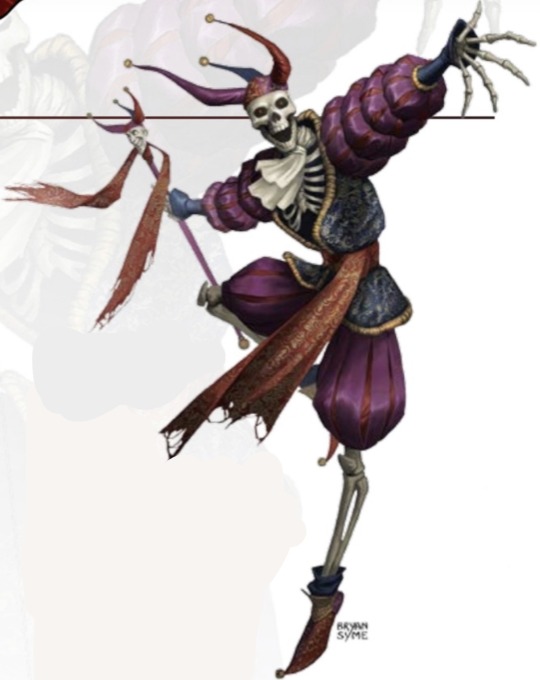
Image source: Tome of Beasts, pg. 240
“A skeletal cadaver decked in the motley attire of a fool capers about while making jokes that mock mortality.”
Grim Jesters are capricious beings that thrive on evil jokes and cruel mischief. They are spawned when a jester on their deathbed amuses a God of death or similar being, and is rewarded with a strange undead existence. Their reason for existence is to kill mortals in ever more twisted and creative ways, in order to entertain the dark gods that gave them unlife.
Dark Humor. Grim Jesters have a unique ability known as the Killing Joke; Their humor can physically harm and even kill its victims. These jokes are often strange and referencing events and things outside of this reality, and some believe Grim Jesters have an insight into the universe other beings lack. Their jokes can be absurd, on-the-fly, insulting, or sheer braggadocio.
Randomness. Grim Jesters live for chaos, in many ways. They often aim to get their hands on magical items in order to supplement their abilities. Beware a Jester wielding a rod of wonder, scrolls of chaos magic, or even a deck of many things.
Ideas for using a Grim Jester in your campaign:
A Grim Jester has become fixated on the party, and is constantly setting up traps and scenarios to try to kill them in ever more convoluted ways.
A mistreated court fool has come back as a Grim Jester, and is causing the court he used to serve to devolve into chaos as he enacts his hilarious revenge on the nobles who trampled him in life.
A Grim Jester is not dissimilar to a Pact Lich in many ways— They are both granted undeath at the whim of a powerful being, and both must appease their patrons in dark ways.
Grin Jesters are strange anomalies. They know more than they should about their victims, and even have access to secrets about the multiverse they would’ve never known in life.
The fact that they only use this knowledge to fuel their strange humor would be a blessing were it not so horrific.
- A Weird Warlock.
4 notes
·
View notes
Text
Spells & Sorcery: Illumination Magic
Source: Deep Magic
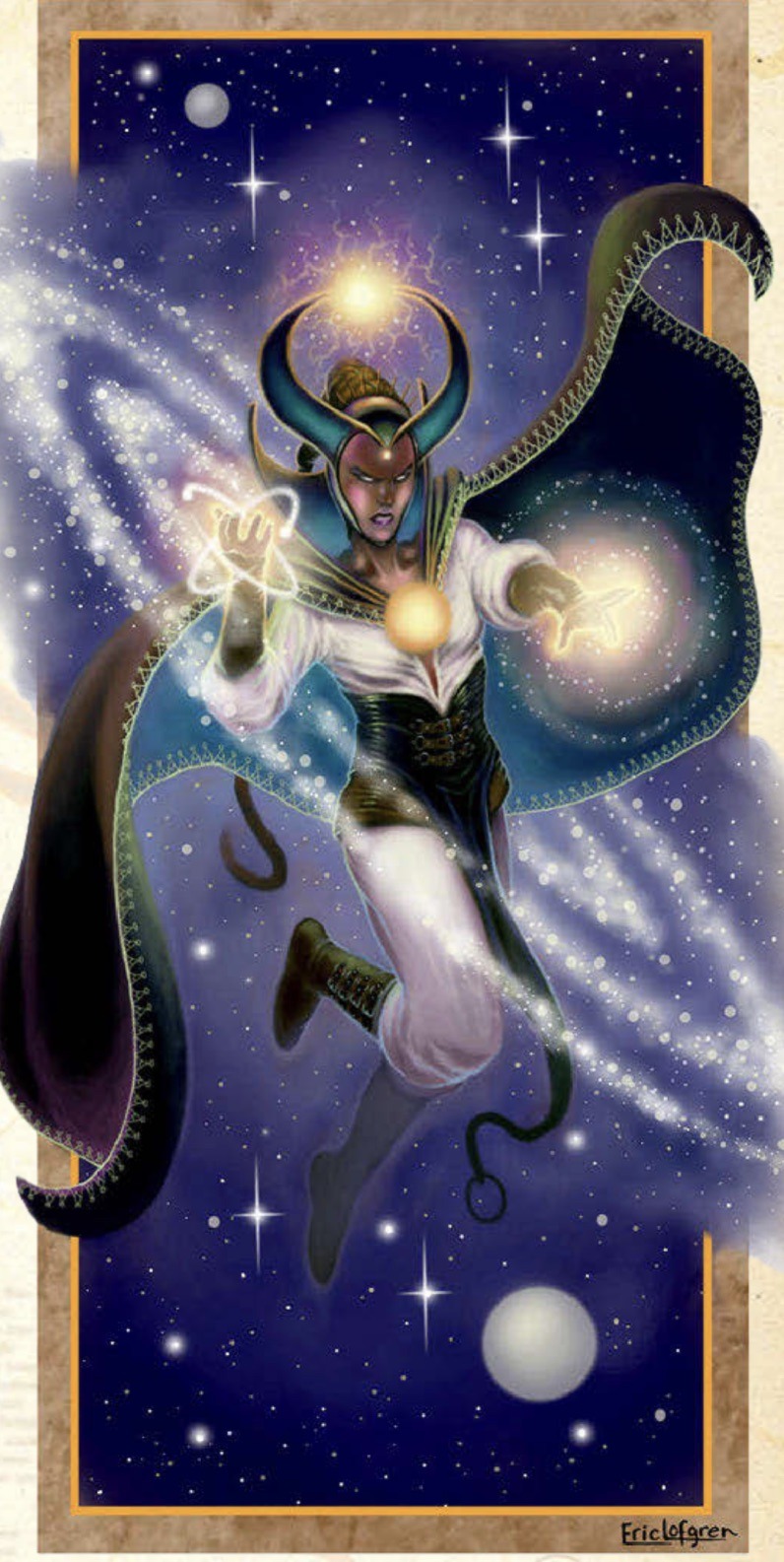
Image source: Deep Magic, pg. 33.
“The school of illumination includes the study of star and shadow magic. This strange magic is rare outside the knowledge of a few elven wizards, who regard it as more a curiosity than anything else.”
Also known as Star and Shadow magic, Illumination Magic is a poorly-understood school of magic, as many Spellcasters and institutions believe it shouldn’t even be its own school. It is closely related to illusion magic, with some knowledge being drawn from creation, Conjuration, and necromancy. It is believed by many that Illumination was invented by Shadow Fey— certainly, this magic does draw power from shadow.
Drawn from Balance. Star and Shadow magic is drawn from the plane of shadow, but also is supplemented with knowledge of the stars and their alignments. Similarly to how elemental Spellcasters draw from the elemental planes, Illumination casters power their spells through the balance between dark and light, stars and shadow.
Mysterious Force. The school of Illumination is very similar to Abjuration, Conjuration, and Divination in the sense that very little is known about it beyond its practitioners. The users of Illumination magic draw power from the stars and the voids they dance in, forces that are obscure and unknown to the rest of the world.
Power in the Dark. Star and Shadow magic is popular among explorers and their Ilk due to its usefulness in the dark. It matters to users of shadow or light magic, and spells of this school are more potent when cast at night, In visibility of the cosmic bodies.
Cosmic Events:
Stars and other celestial bodies float throughout the cosmos, objects that Illumination casters can use to fuel potent spells and magical effects. Certain cosmic events can alter the effects of Star And Shadow magic, such as:
Alien Incursion: When aberrations from the stars enter this world, the world fights back. Illumination spells damage aliens.
Comet: Comets are symbols of change and instability, Illumination spells are unpredictable during this time.
Lunar Eclipse: The eclipse weakens the powers of lycanthropes and the undead. Illumination magic damages these beings during the eclipse.
Meteor Shower: Meteors interfere with summonings and Conjurations, and Illumination casters have a difficult time summoning monsters from other worlds during a meteor shower.
Meteor strike: When a cosmic body plummets to the ground, magic becomes agitated and harmful. Evocations cast by illumination casters are empowered during this time.
Nova: The birth or death of a star is a very auspicious time in history— divinations cast during a Nova event always yield accurate information.
Planetary Conjunction: The overlap of two cosmic bodies influences the minds and actions of living beings. Spells meant to manipulate or deceive are empowered during these events.
Solar Eclipse: These eclipses plunge the world into darkness, empowering spells of darkness or evil.
Ideas for using Illumination Magic in your campaign:
An elven Wizard who has studied Illumination for centuries is looking to complete his collection of spellbooks. The final tome he desires is held in a dungeon made of complete darkness. He is willing to share some knowledge of Illumination magic for adventurers who will brave the keep to retrieve the book for him.
A guild of Star and Shadow mages are looking to build a massive astrolabe, one that will allow them to better channel the power of cosmic events. They were waiting for the final piece to arrive when the courier delivering it went missing.
The school of Star and Shadow magic is a potent yet mysterious school, full of wizards and other Spellcasters who toe the line between alien darkness and pure light.
While any diviner can measure the astral bodies to view future events, the Illumination school taps into cosmic events to create powerful spells drawn from the night sky and the stars held within.
Illumination magic requires great study and a strong will, for not everyone can handle the knowledge of the stars.
- A Weird Warlock.
2 notes
·
View notes
Text
Mighty Monsters: Corrupted Pixies
Source: Tome of Beasts 2

Image source: Tome of Beasts 2, Pg. 72
“A wrinkly, purple-skinned pixie with small black horns and bat wings flits about, singing a song about harvesting organs.”
Corrupted Pixies are small, innocent fey that are corrupted into fiends through dark magic and horrific deeds. They delight in violence, often orchestrating murderous “pranks.”
Twisted by Hags. The most common origin of a Corrupted Pixie is through capture by a Hag, who torture them by making them witness their crimes. These acts, combined with magic, turn the Pixies into mad, dark versions of their previous form. They become fiends in service to the Hag that created them, and view their “Mothers” as deities of murder, sacrifice, and darkness.
Mischievous Fiends. Corrupted Pixies love nothing more than murder and pain, and hand both out with childish glee. They are prone to going on hateful prank sprees, inflicting as much damage to the beings and area as they can. They like to use their magic and deceit to force other beings to attack eachother, and try to make their pranks go on as long as possible before reaching a murderous and satisfactory end.
Hatred of Beauty. Like their creators, Corrupted Pixies abhor beauty. They despise attractive mortals, sylvan glens, and works of art. Their pranks are often more cruel towards these things, as they aim to mar anything beautiful they find.
Possible Salvation. While Corrupted Pixies only vaguely resemble their fey cousins, it is possible to restore one of these beings to their old form. Should a Corrupted Pixie be captured and showered with pixie dust for 10 days, they will be freed from their vile form.
Ideas for using Corrupted Pixies in your Campaign:
A powerful Hag has been cultivating a swarm of Corrupted Pixies over the course of years, and is aiming to unleash them on a nearby kingdom. An Archfey reaches out to the party, urging them to save the Pixies from the Hag’s Influence.
A Druid has captured a Corrupted Pixie in the hopes of returning it to its former glory, but her stores of pixie dust is running out. She offers a magical item to the Party should they go out and collect more for her.
An old Corrupted Pixie has lived to see a rare event; Her Hag creator has died. Now free from control, and with the Hag’s arsenal of magic items, she is unleashing pain and misery across the area.
Corrupted Pixies are a sad sight— beings of joviality and mischief turned into evil fiends.
Only the most evil and twisted beings actively seek to create these beings. Due to the horrific methods by which a Corrupted Pixie is created, they become sadistic, pain-obsessed monstrosities.
Fortunately, Corrupted Pixies can be saved by those willing to help them. And a grateful pixie could be a good way to get on the Fey’s good graces.
- A Weird Warlock,
4 notes
·
View notes
Text
Mighty Monsters: Hags.
Source: Volo’s Guide to Monsters.

Image source: Volo’s guide to monsters.
“Hags are crones who represent the corruption of ideals and goals, who delight in seeing the innocent brought low.”
Hags are mysterious and unpredictable, especially in the perspective of mortals. The same hag that spends her time luring in and eating children could then be found making jokes and offering sinister advice to adventurers.
Ugly and Ancient. Hags perceive beauty as vile and disgusting, and ugliness as the epitome of beauty. They often spend their time “improving” their appearance with shredded clothes, mudstains, and illusion magic. For their warped sense of aesthetics, Hags were banished from the beauty-obsessed courts of the Fey. Only the most powerful hags, who cannot be ignored by the Fey kings and queens, can attend the courts without issue. Hags are immortal but not youthful; They constantly get older and uglier. The older a Hag is, the more knowledgeable they are on their dark magic, and the more weight they pull with other hags.
Corrupting Crones. Hags delight in the perversion of goodness and the manipulation of the weak. The desire to sow chaos and misery is the driving force behind so many hags building their lairs near humanoid settlements. They spread this corruption and pain most effectively through dark bargains with desperate folk.
Damning Bargains. People with nowhere to turn make a hag’s best customers, as they are often willing to give anything to get what they want. Hags will set up meetings, usually appearing when a potential victim is at their lowest. While they could be seen as similar to devils in this regard, they have strictly different modes of operation when corrupting the innocent. While a devil will often go out and find weak-willed mortals to damn, a Hag is content to sit and tend to her own work, waiting for others to come to her. This approach gives her much of the power in the scenario, as desperate souls will come to her, seeking cures or spells to solve their problems. Despite the miraculous magic Hags can enact, there is always a catch— one that will oftentimes being more pain and suffering than if the Hag hadn’t gotten involved at all.
Deals & Desire. Despite their foul reputation, Hags still have no shortage of visitors seeking their dark magic. With their repertoire of arcane knowledge and strange items collected over their long lives, hags often can offer just the right “solution” for whatever ails their victims. They know just the right ways to tempt mortals into their bargains, always giving their victims just the right conditions to satisfy their desires for a time.
Bargainer Beware. A Hag’s offer is never as simple as it seems. A Hag will never let their customers walk away happy, as they exist to spread misery and evil. A farmer seeking a cure for his son’s disease will discover the cure only lasts for a short amount of time, and must regularly be refreshed. A person looking to return an errant lover will find them growing obsessive and murderous. Every hag has unique ways they like to betray their victims, always in miserable ways that will bring their victims back into their clutches.
Weird Magic. With their nearly unending lifespans, Hags have all the time to master their strange brand of witchcraft known as “Weird Magic.” This dark magic is characterized by imbuing objects with curses and dark magic, with each hag having their own unique collection of weird magic items. Each Hag’s magic is unique to them, so many individual hags come together to form dark sisterhoods known as Covens. Within these covens, they share their knowledge of Weird Magic and spells to better spread misery.
Changeling Children. As a race of inhuman crimes, Hags do not procreate naturally unless the partner is suffering from some sort of insanity. When they do, the beings created from their union are known as Changelings. While many do it the old fashioned way, either through shapeshifting or manipulation, there is another way hags create more of their own. When a hag has need of a Changeling, either to form a coven or to enact some scheme, they collect a mortal infant, devour it, and then a few days later birth an identical-looking Changeling child. These children eventually grow and mature like normal, but near adulthood begin to experience a strange psychic urge known as “the Call,” causing them to seek out and find their Hag mother to complete their transformation.

Image source: Blood of the Coven, pg. 2.
Breeds of Hags:
There are many different kinds of Hags, all depending on the environment they live in and their natures:
Annis Hags are the most physically powerful of Hagkind, but have a lesser capacity for magic. They usually craft simple plots, desiring only murder, betrayal, and cannibalism. They are sometimes called “Iron Hags,” due to their invulnerable skin and sharp claws.
Ash Hags believe the world and all the life within it are unclean and disruptive— they seek to cleanse the world and their victims through flame. They hate the human arrogance of taming flame, and punish their victims with mockeries of the forge— branding them with molten iron and feeding them ashes.
Blood Hags, also known as Socouyants, are the most social of hags. They enjoy living among mortals, and use their abilities to steal the skins of beautiful maidens to hide their true form, of a horrific magical flame.
Dreamthief hags are the stronger cousins of Night Hags, as they maintain immense power of the minds and souls of mortals. They possess venom that disables thoughts, enabling her to meddle with the sleeping mind.
Green Hags thrive on drama and manipulation. These Hags excel at using illusions and shapeshifting, and are well-known for impersonating others to complicate situations.
Mute Hags are the only known Hags that didn’t originate as changelings; They simply manifest when a woman with arcane abilities grows resentful and hateful enough. Due to their genesis, Mute Hags are a breed of evil above all hagkind.
Night Hags are created from the souls of truly black-hearted hags upon death. They arise as fiends with Hag magic, and serve as traveling merchants in the Lower Planes. They are capable of moving through the Ethereal plane to enter mortal dreams, corrupting them and stealing their souls to sell for the highest bidder.
Sea Hags are the most horrific and ugly kinds of hag. Their very gaze can physically harm those who face it, and they have a natural talent for cursing others. They dwell within the water, and love to lure beautiful beings beneath to maim them.
Storm Hags are isolated, spiteful beings that would love nothing more than to be left alone to wallow for eternity. Unfortunately, the actions of mortals and nature irritate them endlessly, and they feel that anyone they lay eyes on has crossed them personally. Storm Hags utilize their connection to the weather to punish happy towns and jovial individuals.
Winter Hags are horrible old crones with frozen hearts. They do not understand empathy or love, only viewing them as weaknesses to be exploited. Despite their cynicism, Winter Hags all have an innate desire to be worshipped, and will often bully arctic communities into making offerings to avert their wrath.
Ideas for using Hags in your campaign:
A Coven of green hags is causing drama in a nearby town. They are constantly shapeshifting into different people to spread rumors and commit crimes, and eventually haven the entire town at eachother’s throats.
A Dreamthief Hag has captured the mind of a member of the party, and is willing to give it up should the party offer her a more interesting mind.
The party is sent after a magical ring said to cure even the most horrific wounds. It was last seen on the finger of a well-known adventurer, who went missing after going out to hunt down an Annis Hag. The party tracks her down to find the ring— which is currently in her stomach, along with the adventurer.
Many sources argue on the true nature and origins of Hags.
Some believe they are corrupted Fey, or what remains of a cursed race. Many folk consider them manifestations of the world’s fear of age, women, and the cruelty of nature.
It may never be known where their origins lie, but some truths are known. Hags can be found in any environment, and they are all cruel-hearted witches that thrive on teaching lessons to the weak or innocent.
Despite their murky reputations, Hags are an ancient race with untold knowledge. They are capable of feats of magic unseen anywhere else, and possess arcane secrets lost to the centuries.
I’m this regard, Hags are a double-edged sword of a species. They thrive on pain and dark intrigue, yet are excellent sources of knowledge and wisdom.
- A Weird Warlock.
2 notes
·
View notes
Text
Spells & Sorcery: Chaos & Wonder Magic.
Source: Deep Magic.

Image source: Deep Magic, pg. 21.
“So tightly intertwined that they are nearly inextricable, chaos and wonder magic feed off the raw power that underpins all of existence.”
Chaos and Wonder magic are two schools that are forever intertwined, as one cannot exist without the other. It is believed that without the magical currents of chaos and wonder, there would be no natural order in the universe. Chaos is just as important as law, and Wonder is the natural counterpart to logic.
Unknown but Depended upon. Very little people truly know about these Magics, but a few Spellcasters have managed to throw themselves into the study of Chaos or harnessing the wild powers of Wonder. Through painstaking experimentation, Spellcasters have managed to extrapolate studies of magic based around these forces. No matter how they are used, Chaos and Wonder spells are always manic, unpredictable, and twisted.
Chaos Magic:
Chaos magic is a powerful arcane force with absolutely no rules or reason, only a random addiction to change. This magic will constantly twist and change anything it comes into contact with, and Spellcasters that dabble in chaos will inevitable spread this change.
Madness-Inducing. A Spellcaster devoted to Chaos Magic can expect a high toll to be exacted in the form of extreme highs and lows. An eccentric lifestyle is common amongst Chaos Magic specialists, with outright madness afflicting some of the most accomplished Chaos Mages.
Wonder Magic:
With chaos magic representing the random rearranging of reality, wonder magic causes change based on the desires and subconscious whims of those nearby. To the uninitiated, wonder magic seems nonsensical, but in reality it simply mirrors the mind and soul of its user.
Favored by Fey. Wonder magic, with its unique effects and ability to bring glamour into reality, I’d especially favored by the Fey. It is as capricious as its wielders, however, capable of scanning the thoughts of beings nearby and altering reality according to their desires.
Using Chaos & Wonder Magic in your campaign:
A town begs the party to go investigate the tower of their resident wizard, who hasn’t made a public appearance in weeks. If the party chooses to look into his sealed keep, they discover he has tapped into a font of chaos magic, and in his insanity is preparing to unleash a magical blast to destroy the town.
A Fey trickster happens upon the party while they are sleeping, and decides to pull a terrifying prank. Each of the party members awakens in their own personal mind scape, trapped there with wonder magic and forced to face their biggest regrets and worst decisions. Characters who realize the illusion can join the others’ mindscapes, helping them to overcome the riddles.
The party happens upon a town plagued by strange and whimsical creatures. Beings conjured straight from the mind of a child harass residents and visitors alike. These monsters are brought into existence by a strange child living in the town, who has accidentally tapped into wonder magic.
Chaos and Wonder are some of the most profound arcane forces in reality, yet very few in the multiverse actually understand them. Only the insane Chaos Mages and deceitful practitioners of Wonder magic can claim to master these forces.
Chaos magic certainly takes a horrific toll on its practitioners, spellcasters capable of simply changing and buckling reality on a whim. It is no wonder so many of them go mad, given that for them, reality is a choice.
Wonder magic is even more obscure, but eternally bound to chaos magic. It knows the hidden fears, regrets, and desires of every being it comes into contact with, and creates illusions and false realities to cater to these whims. If a mortal ever learned these practices from the Fey, they are bound to be even more insane than a Chaos Mage.
- A Weird Warlock.
2 notes
·
View notes
Text
Astonishing Artifacts: The Codex of Infinite Planes.
Source: Pathfinder Campaign Setting: Artifacts & Legends.
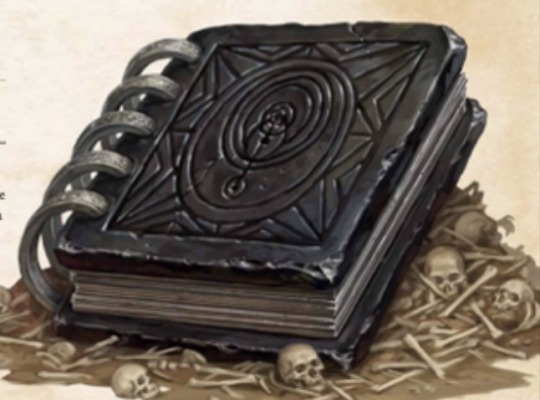
Image source: Pathfinder Campaign Setting- Artifacts & Legends, Pg. 19.
“Thick slabs of obsidian bind pages of fine lead, creating a massive tome riddled with pocks and scars suggestive of fantastic antiquity.”
The Codex of Infinite Planes is an enormous tome, usually requiring two people to properly handle, and has a seemingly infinite length of pages. It offers incredibly vast knowledge of the multiverse, at the risk of being totally annihilated by the power of the book.
Risk and Reward. When a being first reads the Codex, their will is tested by the multiverse. Should they be deemed unworthy, they are destroyed and wiped from reality. If they succeed, all the knowledge held within can be accessed, granting information and powers relating to planar travel.
Planar Catastrophes. When the powers of the Codex are used, there is always a slight risk of triggering some calamity. These dangers are seemingly random, yet always have disastrous effects on the user and surrounding area.
Destruction. The Codex can only be permanently destroyed if every single page is ripped out and left on a separate plane. Given the powers held within the Codex, this sounds relatively simple, but just the act of tearing a page out of this book will always immediately trigger a catastrophe.
History of the Codex of Infinite Planes:
Few in the multiverse recollect when the Codex was created, and for many its origins are lost to antiquity.
In a time before the first mortal races walked the planes, the Titans were rebelling against the gods to try and take their divine power.
They realized they couldn’t defeat their enemies without some connection to the multiverse, and sought to twist the planes to their will.
The result of this ultimately failed but fantastic bid was the Codex of Infinite planes, a tome allowing a being to access the multiverse.
The punishment for the creation of this book was swift, and the titans and gods fought in an eon-spanning war.
The Codex eventually was lost, and has gone through periods of inactivity over time. It shows up throughout history, offering miraculous power and information but inevitably devastating the societies that unearth it.
Catastrophes & Ramifications:
Each time the powers of the Codex are used, there is a chance it will trigger some event determined randomly by the book.
Some of these possible events are:
The reader and everything in a 5-mile radius is transported to a different plane.
A vicious storm centers on the area, followed by periodic earthquakes.
A small group of fiends are summoned with one goal: To kill the reader.
The reader’s soul is permanently captured in a mundane gem.
Every dawn after triggering the catastrophe, the reader reincarnates into a new form.
Evil clones of the reader from other dimensions begin appearing in the area, each bent on killing the reader.
Hundreds of spirits pour out of the book, each determined to kill a specific mortal.
The reader’s soul is permanently bound to their body and barred from the afterlife; If they die, their spirit stays in their inanimate body.
The reader becomes colossal in size, and continues to grow every day.
The reader’s energy is drained by the book, constantly hobbling and weakening them daily.
Any time the reader interacts with magic, it risks being unraveled.
The reader becomes known by a specific deity, who vows to destroy them by any means.
All magic in the area permanently stops functioning.
Magic becomes twisted and warped, creating a pocket of wild magic in the area.
The land within a few miles of the reader is permanently cast into darkness.
The temperature of the area raises 40 degrees as the sun halts in the sky.
All creatures in the area risk dying and immediately coming back as highly infectious zombies.
2 titans appear and immediately begin to fight over the Codex.
A meteor shower pummels the area.
Gravity in the area is distorted or reversed.
Every being within 20 miles except for the reader permanently switches alignment.
The reader permanently swaps bodies with their greatest enemy.
The reader drops dead, killed by a spell. If they are too strong, the Codex repeats this effect until they die.
Constant Search. Beings across the multiverse are constantly seeking the Codex out. Many different factions are interested in its use, as access to the multiverse is something nearly any being wants. Some beings wish to use it selfishly, bending the planes to their will, while others wish to hide it from those that would use it for evil. Regardless of the intentions of the reader, the Codex causes tragedy wherever it resurfaces.
Ideas for using the Codex in your campaign:
The party is working on an unrelated objective when they are caught in the effect of one of the Codex’s Catastrophes. They must find the Codex and stop its reader before they trigger another.
The party requires access to a closed plane— possibly the dimension of time, a hidden layer of the Abyss, or some other obscure and hard-to-reach place. The quickest way to get to this place would be to risk using the Codex, if they can find it.
A group of titans have appeared in the realm, threatening to destroy the area with their schemes. The party must seek out the Codex to use as a bargaining tactic to make the Titans leave their plane.
Many beings, myself included, would risk much for access to the Codex of Infinite Planes.
Imagine if you had the powers this book offered— Planar travel, powerful spells, and knowledge regarding the multiverse. Who wouldn’t risk it all for that?
That is a part of the inherent danger of the Codex. So many factions across reality are ever searching to use it, with very few realizing the calamity that would follow.
Not many beings in the multiverse are strong or responsible enough to wield the power of the cosmos.
- A Weird Warlock.
#wowieweirdwarlock#pathfinder#ttrpg#pathfinder lore#codex of infinite planes#planes#WWW: Astonishing Artifacts
4 notes
·
View notes